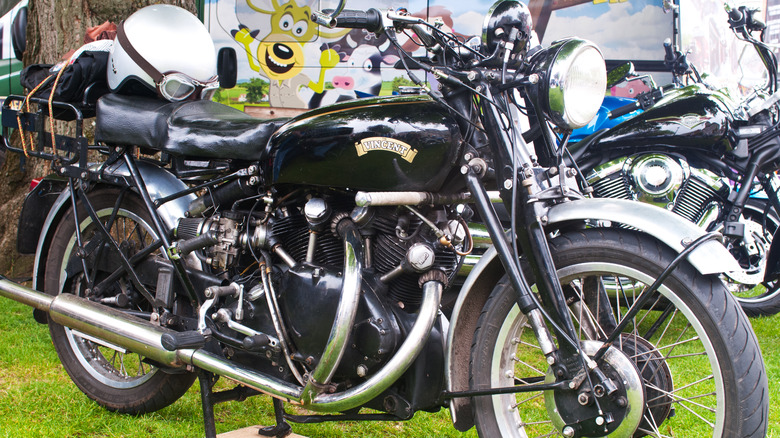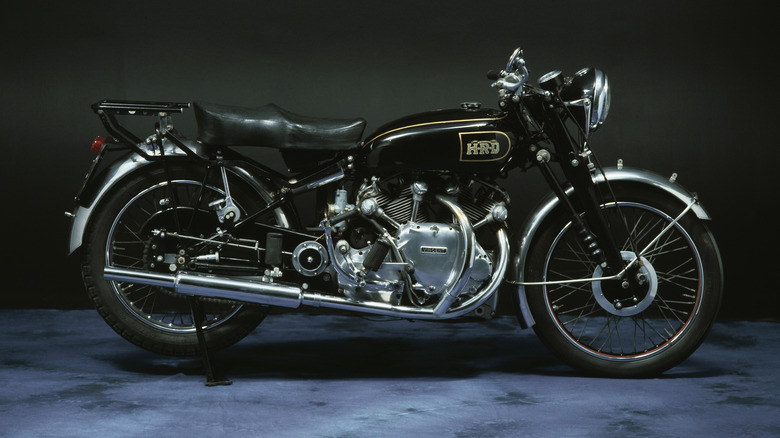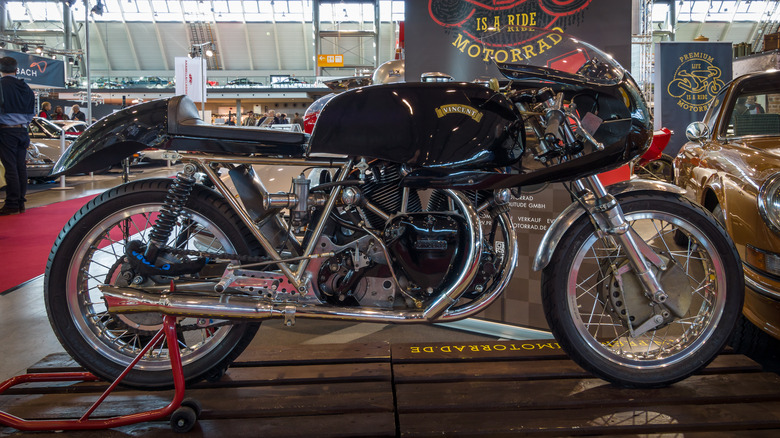What Ever Happened To Vincent HRD Motorcycles
If you take a look at the most popular and well-known major motorcycle brands today, you'll find that many of them have a storied history dating back anywhere from decades to more than a full century ago. From Harley-Davidson to Yamaha, many of these long-standing manufacturers started building up their popularity long ago, and have thus managed to craft an enduring and ubiquitous legacy in the time since. However, it's important to remember that not every company that was once a popular force in its respective industry is still around today. Case in point: Vincent HRD, a once-revered motorcycle manufacturer that is now mostly relegated to the minds of diehard enthusiasts.
Originating in 1928, the British motorcycle manufacturer Vincent HRD would go on to give birth to some of the most iconic models of the 1930s and 1940s — including the ultra-fast Vincent Black Shadow. The company's bikes were particularly well-received for their sleek designs and ability to reach exceptional speeds compared to the competition, and were generally considered to be a premium pillar of the industry. However, more than 80 years past Vincent HRD's heyday, the once-beloved entity isn't around in any major capacity. Here's what happened to Vincent HRD, and how it went from a well-known force to little more than a distant memory.
Vincent HRD went under after WWII
The original Vincent HRD is completely defunct, and has been for the better part of a century at this point. The company's final era was something of a roller coaster ride, as it went from enjoying moderate success to suffering dire financial struggles in a relatively short span of time.
In the time leading up to World War II, Vincent HRD was doing fairly well. The manufacturer had established itself as a provider of expensive yet well-crafted motorcycles, and its Series A Rapide model proved popular. As with many other production centers, wartime saw Vincent HRD make the transition to manufacturing goods for the Allied forces, and it emerged from the time of the conflict with plans drafted for new and improved motorcycle models. Indeed, 1948 saw the introduction of the Vincent Black Shadow, a now-iconic vintage motorcycle and arguably the company's most popular model ever. However, while the immediate years following WWII went smoothly, Vincent HRD's momentum would soon start to peter out.
As Europe had faced substantial devastation during the war, production centers in the transportation industry subsequently shifted from creating expensive luxury goods to cheap and affordable products. Budget cars and motorcycles took control of the market, and Vincent HRD's high-priced, handcrafted bikes lost their foothold. Instead of adapting the brand to this societal shift, company owner Phil Vincent staunchly refused to allow any reductions in quality for Vincent motorcycles. Even the culling of the HRD portion of the Vincent name and a focus on the American market wasn't enough to stop the manufacturer's downward spiral.
Faced with catastrophic financial losses, Vincent HRD went bankrupt in 1955 and was subsequently shuttered. The final motorcycle would be released later that same year, shutting the door on the manufacturer's stint in the industry.
There have been various revivals for Vincent motorcycles
While the original Vincent HRD went out of business in 1955, the ensuing decades have seen numerous attempts from various parties to bring the brand back to the forefront. In 1994, entrepreneur Bernard Li purchased the rights to the Vincent name. Four years later, he would launch the America-based Vincent Motors USA, with the intention to develop and distribute modernized successors to classic Vincent HRD motorcycles. Unfortunately, though several prototypes were produced, the revival effort was ultimately cut short by Li's untimely death in 2008 due to a bike crash.
Vincent motorcycles themselves have managed to survive by way of licensed models from other manufacturers over the years. HRD Engineering — an Australian company with no relation to the original Vincent HRD — has produced a number of Irving-Vincent motorcycles, which mix the classic qualities of old-school Vincents with some more modern sensibilities. Then, there's the JMC Classics-made Egli-Vincent, which is a Vincent motorcycle that features a custom Egli frame. Other recreations of the Vincent exist as well, though arguably none of them maintain the level of popularity and market presence that the original Vincent HRD once held.
Though Vincent HRD is one of the various classic motorcycle brands that aren't around anymore, there's always a chance that Vincent motorcycles could see a large-scale resurgence. As recently as 2022, reports spread from outlets like India Times that the India-based manufacturer Bajaj Auto has acquired the rights to the Vincent brand. Whether it's through Bajaj or some other effort, it appears that Vincent motorcycles still have a solid future ahead of them.


